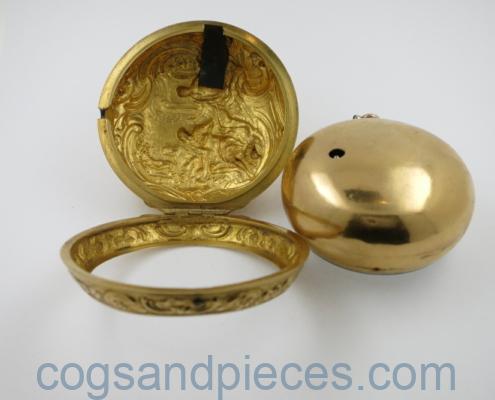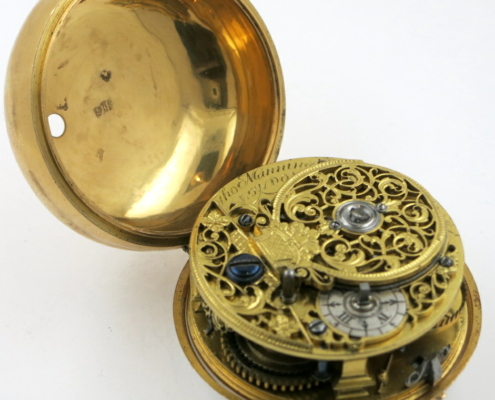Mid 18thc. shagreen & gold repousse triple cases
Stock No. 1885
Thomas Manning
London, 1742
Gold repousse triple cases, 58.5 mm
Verge escapement
Sold
A mid 18th century London pocket watch, in gold repousse pair cases, with a further protective gilt/shagreen case.
MOVEMENT : Gilded verge escapement, with beautifully engraved and pierced winged balance cock. Four square baluster pillars, large silver regulator disk, large diamond endstone and clean steel screws.
Signed Tho. Manning, LONDON.
The movement is in particularly good original condition, and is running well.
DIAL : A fine white enamel dial.
In good condition, with no chips, hairlines or repairs and just a few light marks and scratches.
Good 18th century matching arrow head gold hands.
INNER CASE : Gold, with rubbed hallmarks for London, 1742. Maker’s mark J*C.
In good condition but with some light bruises and slight compression around the band.
The bow and stem (also tested as gold) appear to be original.
The hinge is fine and the bezel snaps shut nicely. The high dome bull’s eye crystal is good.
MIDDLE CASE : A gold (tested) repousse pair case, decorated with a Classical scene showing three figures, the female seated at the centre.
In very good condition, with just some light wear to the high points, mainly to the three figures. No holes. The catch and hinge are fine and the bezel snaps shut correctly. The catch button has worn down but has been filled and operates correctly.
The gold cases, excluding crystal weight about 55 gms.
OUTER CASE : Gilt brass with shagreen/leather covering. Ornate pinwork to the bezel, back rim and centre of the back.
The gilt brass is in good condition, with very little wear to the gilding except for the catch button where the gilding has worn down to the brass. The hinge and catch are fine and the bezel snaps shut nicely.
The shagreen or leather covering retains a very good colour and is in nice condition. Just one small patched repair on the bezel at 8.
The pinwork is also in good condition, with all of the ornate rosette pins present and just a few of the smaller plain pins missing.
The dial on this watch appears to be of a slightly later style that the movement, probably from towards the end of the 18thc. Both dial and dial plate are of the correct size and have been expertly fitted. The watch may originally have had a gold champleve dial, and like so many in the later 18thc., was converted to an enamel.
Thomas Manning is listed in London, pre 1776.























